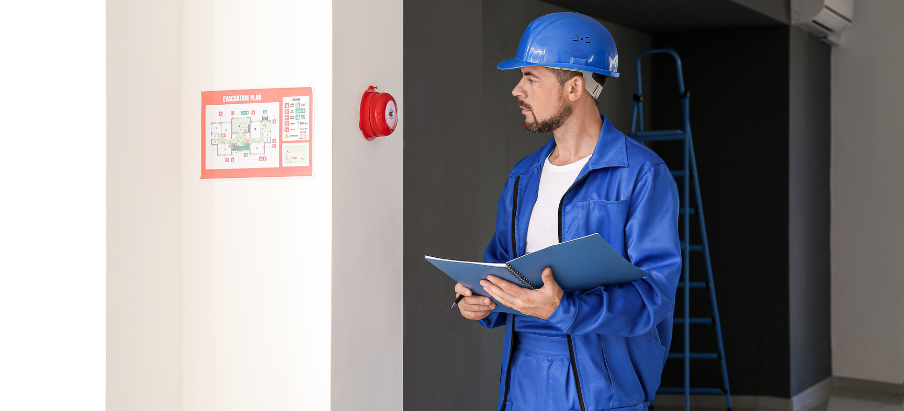
Need assistance?
Need Assistance? Call Us 0330 058 0631





















 Book a service
Book a service

09/07/2024 • by Lynsey B

In the UK, fire safety regulations are primarily governed by the Regulatory Reform (Fire Safety) Order 2005. This is also often referred to as the Fire Safety Order or RRFOSO. This guide will delve into various aspects of the Fire Safety Order, including who it applies to, the responsibilities under the order and how to find a competent fire risk assessor.
The Regulatory Reform (Fire Safety) Order 2005, also known as the Fire Safety Order (FSO), is legislation that consolidated various older fire safety laws into a single, legal framework. It came into force on 1st October 2006 and applies to all non-domestic premises in England and Wales, including the common parts of multi-occupied residential buildings.
The Fire Safety Order focuses on the assessment and mitigation of fire risks. It places the responsibility on those who have control over the premises to ensure the safety of all occupants and visitors. It is designed to be a more flexible approach to fire safety compared to previous regulations, ensuring that fire safety measures are tailored to the specific risks of each property.
The scope of the Regulatory Reform (Fire Safety) Order 2005 (RRFSO) is extensive. It includes a wide array of non-domestic premises across England and Wales. This legislation was introduced to consolidate and simplify fire safety regulations. It ensures a consistent approach to fire prevention and safety management.

Firstly, workplaces form a significant category under the RRFSO. Whether it is an office, a factory floor, or a construction site, any place where employees carry out their duties falls within the remit of this order. Employers are particularly responsible for ensuring that adequate fire safety measures are in place to protect their workforce.
Public buildings such as schools, hospitals, and care homes are also covered by the Fire Safety Order. These premises often host vulnerable individuals who may require assistance in the event of a fire. The legislation mandates that responsible persons in charge of these facilities implement tailored fire safety measures. This must include evacuation plans that account for the needs of those with mobility issues or disabilities.
Hotels and guesthouses are another category under the RRFSO. These establishments accommodate temporary guests who may not be familiar with the layout or evacuation procedures. It is the management's responsibility to provide clear fire safety information and ensure that emergency routes and exits are well-maintained and clearly marked.
Shops and commercial premises, ranging from small retail outlets to large shopping centres, are also subject to the Fire Safety Order. These spaces often have a high density of occupants, including staff and customers. Effective fire safety measures here include regular fire drills and proper storage of flammable materials.
Factories and warehouses, where industrial processes and storage of goods take place, present unique fire risks. This is due to the presence of machinery, chemicals, and large volumes of materials. Compliance with the RRFSO necessitates robust fire risk assessments that identify potential hazards.
Even communal areas of residential properties, such as blocks of flats and houses in multiple occupation (HMOs), are covered by the Fire Safety Order. While individual flats themselves are covered under separate regulations, communal areas like stairwells, corridors, and shared facilities fall under the RRFSO. This ensures that all residents have safe means of escape in case of a fire and that fire safety equipment like fire alarms and extinguishers are regularly maintained.
Under the Regulatory Reform (Fire Safety) Order 2005, the concept of the "responsible person" plays an important role. They must ensure that adequate fire safety measures are implemented and maintained in non-domestic premises across England and Wales. This term encompasses individuals or entities who bear the primary responsibility for fire safety within a given establishment.

Firstly, the responsible person may be the employer, particularly in workplaces where there is an employment relationship. Employers have a legal duty to ensure the safety of their employees under various health and safety legislation, including fire safety regulations. This responsibility extends to conducting fire risk assessments, implementing appropriate fire safety measures, and providing necessary training to employees regarding fire hazards and evacuation procedures.
In cases where there is no clear employer-employee relationship, the responsible person is typically the person who has control over the premises. This could be a manager, a business owner, or someone else in a position of authority who oversees the day-to-day operations of the premises. They are tasked with ensuring that all fire safety obligations under the Fire Safety Order are fulfilled, including maintaining adequate means of escape, fire detection systems, and firefighting equipment.
Moreover, if there is no identifiable employer or person in control, the responsibility falls on the owner of the premises or any other person who has control over the premises. This could apply to landlords, property management companies, or even individual property owners who lease out commercial spaces. Regardless of ownership status, the responsible person must take proactive steps to comply with fire safety regulations and ensure the safety of all occupants and visitors.

As a responsible person under the Regulatory Reform (Fire Safety) Order 2005, your primary duty is to ensure the safety of everyone who could potentially be affected by fire within your premises. This responsibility includes several key actions that are essential for effective fire risk management and compliance with legal obligations.
Firstly, conducting a thorough Fire Risk Assessment is key. This involves identifying and evaluating potential fire hazards present in your premises. These hazards can range from sources of ignition, such as electrical equipment and heating systems, to combustible materials and substances. Assessing who might be at risk in the event of a fire is important. Take note of employees, visitors, and anyone else present on the premises. The assessment process must be documented if your premises employ five or more people or if specific licensing or registration requirements apply.
Based on the findings of your fire risk assessment, the next responsibility is to implement appropriate fire safety measures. This includes taking proactive steps to reduce or eliminate identified fire hazards. Measures may involve removing or safely storing combustible materials and ensuring that escape routes and exits are clearly marked.
Maintaining fire safety equipment is another big responsibility. All fire safety equipment installed on your premises, must be regularly inspected, tested, and maintained by competent professionals. This includes alarms, extinguishers, emergency lighting, and sprinkler systems. This ensures that they are in good working order and ready for immediate use in the event of an emergency.
Equally important is the responsibility to provide information and training to employees and other relevant persons. The responsible person must inform individuals about specific fire risks on the premises and the measures in place to mitigate these risks. Fire safety training should be provided to all employees, with particular emphasis on those designated as fire wardens or marshals. Training should cover fire prevention techniques, emergency evacuation procedures, and the correct use of fire safety equipment.
Regular reviewing and updating of fire risk assessments and safety measures is essential to maintain effective fire safety standards over time. Reviews should be conducted periodically, especially following any significant changes to the premises, such as structural alterations, changes in occupancy levels, or modifications to business operations. Updating fire safety measures ensures that they remain relevant and effective in addressing current fire risks and compliance requirements.
Enforcement of the Regulatory Reform (Fire Safety) Order 2005 is primarily the responsibility of local fire and rescue authorities. These authorities have the power to inspect premises and ensure compliance with fire safety regulations. If they find that fire safety measures are inadequate, they can take various enforcement actions, such as:
Issuing informal advice or guidance
Serving formal notices requiring improvements (such as an enforcement notice or a prohibition notice)
Prosecuting individuals or organisations for non-compliance, which can result in fines or imprisonment

In certain specialised premises, such as those involving hazardous materials or large public gatherings, other enforcement agencies like the Health and Safety Executive (HSE) or local authority environmental health departments may also have a role.
Finding a competent fire risk assessor is crucial to ensuring that your fire risk assessment is thorough, accurate, and compliant. While responsible persons can conduct their own assessments, engaging a qualified professional becomes particularly advisable for complex or high-risk premises. Especially where specialised knowledge and experience are essential.
One of the first steps in finding a competent fire risk assessor is to check their qualifications and experience. Look for assessors who hold recognised qualifications in fire safety assessment. For instance, those certified by reputable professional bodies like the Institution of Fire Engineers (IFE), the Fire Industry Association (FIA), or the Institute of Fire Safety Managers (IFSM). These certifications indicate that the assessor has undergone rigorous training and assessment to demonstrate their competence in conducting fire risk assessments.
Furthermore, consider the assessor's specific experience in conducting assessments for premises similar to yours. Assessors with a diverse portfolio and experience in various types of buildings, industries, and fire safety challenges are likely to offer a more comprehensive and tailored assessment suited to your specific needs.
Seeking references and reviews is another valuable step in assessing the competency of a fire risk assessor. Ask the assessor for references from previous clients or projects similar to yours. Hearing about others' experiences firsthand can provide insights into the assessor's professionalism, thoroughness, and ability to deliver accurate assessments. Additionally, check online reviews and testimonials on platforms like Google reviews or industry-specific forums to gather feedback from other businesses who have used their services.
Accessing the full text of the Regulatory Reform (Fire Safety) Order 2005 (RRFSO) is important for anyone responsible for fire safety in non-domestic premises across England and Wales. This legislation outlines the legal requirements and obligations that must be adhered to in order to ensure adequate fire prevention, safety measures, and emergency planning.
One of the most reliable and authoritative sources from which you can download the Regulatory Reform (Fire Safety) Order 2005 is the UK Government’s legislation website. This website serves as a central location for all current UK legislation, including statutory instruments like the RRFSO. Here, you can access the full text of the order, which includes detailed information on fire risk assessments, fire safety measures, responsibilities of responsible persons, enforcement procedures, and more.
Downloading the RRFSO from the UK Government’s legislation website ensures that you have access to the most up-to-date and accurate version of the legislation. This is important because legislation may be amended or updated periodically to reflect changes in fire safety standards, practices, or legal interpretations. By referring directly to the official source, you can be confident that you are reviewing and implementing the current requirements applicable to your premises.
We use cookies to enhance your site experience. Choose your preferences below.
